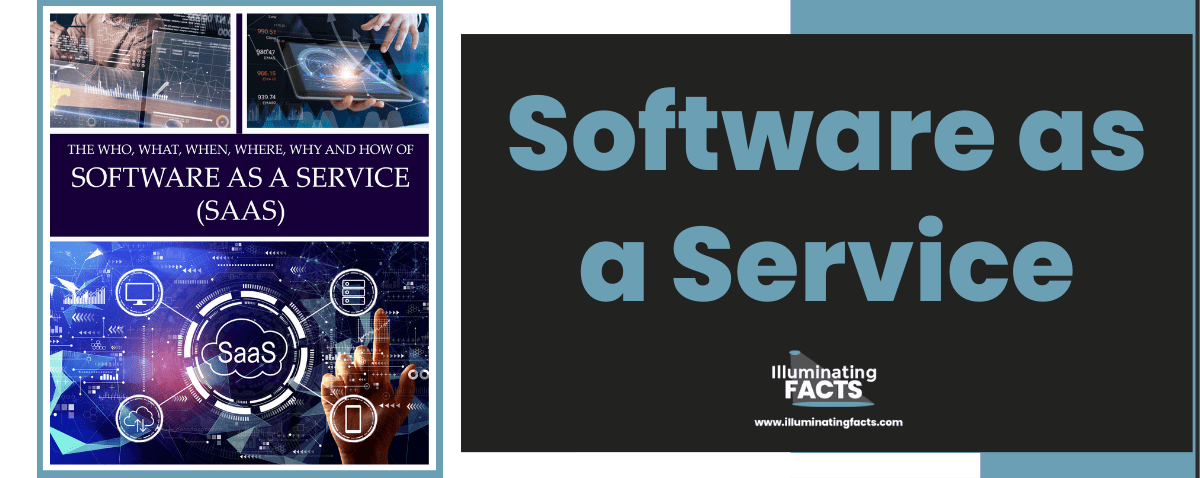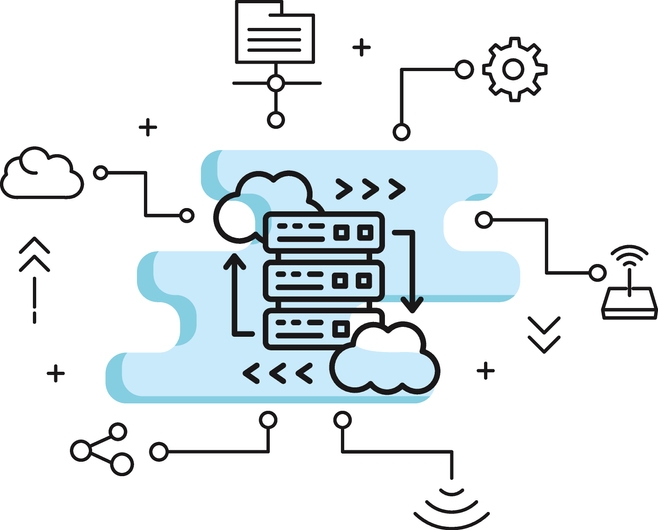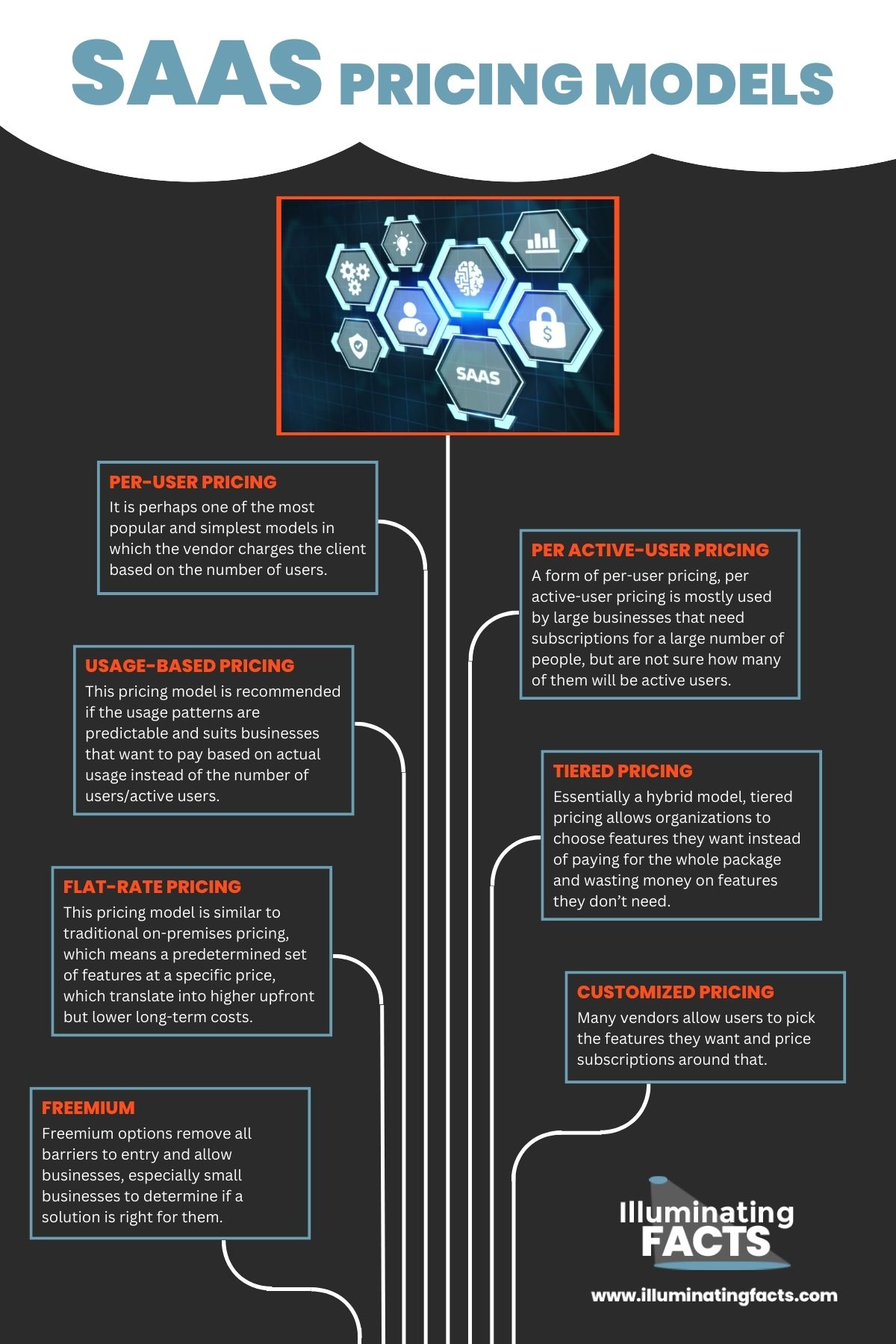Table of Contents
What is SaaS?
Software as a Service is a cloud-based software distribution model in which the service provider hosts the software/applications in the cloud and makes them accessible to users via the internet. Service providers can either contract 3rd party cloud service providers for hosting their app or host apps on their own servers. Larger providers such as Microsoft are also software vendors, while service providers that rely on infrastructure of other cloud providers are known as Independent Software Vendors (ISVs).
The terms SaaS and cloud computing are sometimes used interchangeably, but SaaS is actually a main category or sub-branch of cloud computing. The other two main categories that fall under cloud computing are Platform as a Service (PaaS) and Infrastructure as a Service (IaaS). Whether its personal entertainment or advanced IT tools, SaaS apps are everywhere and are considered to be the future of computing.
Compared to PaaS/IaaS solutions, SaaS solutions are commonly marketed to business-to-business (B2B) as well as business-to-customer (B2C) users. A recent report[i] by McKinsey predicts that by 2024, the market for SaaS solutions is expected to grow to a staggering $200 billion, which is a 20% growth on a year-on-year basis. This shows how popular SaaS solutions have become and the trend is likely to continue in the future as more businesses opt for remote work.
What SaaS Means for Businesses?
SaaS as a delivery model can benefit both small and medium businesses in a number of ways. In most business environments, using cloud-based solutions has become a necessity to stay competitive. Despite the popularity of digital integration, many businesses are still not fully aware of how SaaS can help them gain a competitive advantage.
Many industries such as logistics and distribution have gradually been moving away from traditional on-premises software to modern SaaS solutions. In addition to much lower upfront costs, other benefits of moving to the cloud include:
- No installation or maintenance
- Instant access from anywhere, using almost any device
- High scalability and flexibility
- Provide operational agility
- Automatic updates and security policy implementation
- Better disaster management
- Reduced carbon footprint
- Meet or exceed customer expectations by offering them highly personalized experiences
- Enables businesses to leverage their existing data to develop robust digital strategies
- Easy integration with other business solutions
- Cross-platform compatibility
- Minimizes data duplication and manual errors
- Quick onboarding
- Enhanced support
- Makes it easier to carry out proof-of-concepts
- Rapid product launches
Use of traditional, on-premises software has been steadily declining just like how iTunes and Netflix replaced CDs/DVDs. SaaS and other cloud-based technologies are no longer exclusive to large businesses due to high costs, which allows SMBs to make the most out of their IT investment.
Small businesses now have access to the same technologies that were previously reserved for large enterprises, which makes now the best time for digital transformation. Different ways in which businesses can use SaaS solutions to stay ahead of the curve include:
- Improved operational efficiency due to anytime-anywhere access, business workflow integration and streamlined operations
- Meet customer expectations by offering personalized experiences, better understanding of customer needs
- Levering existing data and using data analytics to acquire new customers and retain the existing base
- Anticipate and track trends and identify new trends using advanced machine learning and AI
- Data visualization helps business determine when and how to approach customers
- Better customer relationship management using CRMs and 3rd party integrations
- A leveled playing field that helps SMBs stay competitive and even compete with large businesses
- Reasonably priced solutions and a large ecosystem means smaller businesses don’t have to hold themselves back because of budget constraints
How are SaaS Apps Accessed?
Instead of buying, installing and maintaining off-the-shelf software, SaaS apps can be accessed using a web browser. Most SaaS apps from reputable vendors also support mobile access and are compatible with a wide range of devices such as tablets and smartphones.
This makes SaaS apps a lot more accessible than traditional software, which restricts users to just a few computers. Consequently, users don’t have to worry about installation and maintenance of the software as the provider takes care of most of the stuff related to hosting an app and keeping it running.
Delivery models such as on-demand computing software delivery and Application Service Provider are closely related to SaaS. These models also host the software and deliver it over the internet to authenticated users. The user data in these models can be stored in the cloud, locally or both locally and in the cloud.
SaaS Architecture: Single-tenant vs. Multi-tenant
One of the main reasons behind the popularity of SaaS apps is the flexibility they offer as they can serve one or more customers simultaneously. Tenancy in the context of SaaS apps refers to computing resources that are separate and hidden from other users of the same private or public networks. The SaaS client here is the tenant.
As the name suggests, single-tenant refers to dedicated resources, including supporting infrastructure and servers. Single-tenant SaaS apps are only meant for specific clients who can customize them according to their own needs. Having separate instances of applications and databases and a high level of customizability comes at a cost. But there are many other benefits too including improved security, easy restoration and backup, reliability, self-hosted migration and individual upgrades.
Multi-tenant SaaS apps refer to apps that are shared between many users who use a single instance and supporting information. Since the app and database are shared, there isn’t much room for customization and significant changes. However, multi-tenant apps have their own advantages including lower costs, efficient use of resources, less maintenance costs, larger computing capacity and shared data centers. These apps are a great option for small and medium businesses that do not plan on investing heavily in cloud computing, but still want to reap the benefits of modern technologies.
Single-tenant SaaS apps are costlier than multi-tenant SaaS apps, require more maintenance and their inefficient use adds up to already higher costs. On the other hand, multi-tenant apps usually experience more downtime and in-app disturbances, and are not as customizable as single-tenant apps. Choosing between the two comes down to the IT budget, level of customizability required and workload.
Large enterprises are willing to pay the premium for ensuring maximum reliability and deep customization. Multi-tenant apps work fine for small and medium businesses that are not bothered much by their limitations and want quick onboarding, less maintenance and ready-made, compliant products.
SaaS vs. PaaS vs. IaaS
What mainly differentiates these three models of software delivery is the level of completeness of the software product. SaaS apps are like finished and ready-to-use products, while PaaS and IaaS provide a platform to deliver software products. Some examples of SaaS apps include Dropbox, Salesforce and GoToMeeting.
Infrastructure as a Service (IaaS) solutions refer to computing resources or data centers that vendors ‘rent’ to clients. These computing resources include servers, networking hardware, storage, physical servers and virtualization resources. The key players that offer IaaS products include (Amazon Web Services), Microsoft (Microsoft Azure) and Google (Google Compute Engine).
The costs of setting up and maintaining high workload computing systems is very high and not all businesses can afford to build these for themselves. IaaS providers outsource their infrastructure to other businesses and save them from having to make large investments. However, the clients still have to manage their data, operating systems and apps.
Platform as a Service (PaaS) refers to frameworks or resources that in-house developers need to build customized applications. The vendor is responsible for providing all the resources needed to support developing such apps. Compared to IaaS, when using PaaS solutions, clients just have to manage their apps and data use. Amazon Elastic Beanstalk, Windows Azure and Google App Engine are some examples of PaaS solutions.
Choosing Between SaaS, PaaS and IaaS
SaaS
Ready-to-use SaaS apps might look like the best option, but that’s not true in all situations. SaaS apps are a better option for businesses and users that need to get started quickly and don’t have time or expertise to deal with the underlying infrastructure.
For example, a retail business that wants to launch an ecommerce store or businesses that need an easy-to-use and affordable collaboration tool. SaaS is also recommended if you don’t need to use apps too often like the tax software or need apps that support mobile access.
PaaS
Platform as a Service solutions are targeted at specific users i.e. developers who need a platform to build and test-drive their apps. PaaS solutions save them from the headache of dealing with the infrastructure, operating systems, storage and software updates, allowing them to focus on development work. The PaaS delivery model offers a cost-effective, highly scalable, reliable and simple way of developing/deploying apps, and significantly reduces the amount of coding developers have to do.
Using PaaS solutions is a necessity in many situations, especially when multiple developers are coding for the same project or when they are working with more than one vendor. PaaS facilitates rapid development and deployment and works great when developing customized apps.
IaaS
IaaS is usually used by businesses that need computing resources on a self-service basis. Instead of heavily investing in the hardware infrastructure, clients simply purchase or rent resources on as-needed basis. The clients get full control over the infrastructure/computing resources allocated to them without having to physically manage a data center themselves.
IaaS is suitable for and used by organizations that have the capacity and expertise to manage almost everything beyond the virtualization layer, including operating systems, apps, runtime, middleware and data. Many IaaS providers also offer more services other than the virtualization layer such as message queuing and databases.
IaaS suits large businesses that want complete control over their apps and data and organizations experiencing rapid growth. IaaS solutions are highly scalable, allowing businesses to evolve quickly.
Types of SaaS Software
Although there are hundreds of SaaS solutions ranging from CRMs to accounting and e-commerce, they can be broadly classified into three main categories i.e. packaged software, collaborative software and enabling and management tools.
Packaged Software
Most of the SaaS solutions fall in this category and range from CRMs to financial management and supply chain management software. These solutions are focused on specific processes e.g. a Human Resource Management SaaS software will focus on employee management, performance reviews and so on. Packaged SaaS software is designed keeping certain business requirements in mind while still providing enough space for customization.
The main idea behind these solutions is to offer a full turnkey solution for complex business needs in the form of a cohesive bundle. Some of the most popular packaged SaaS solutions include CRMs, accounting, business intelligence, marketing and sales, customer feedback management, office suites and document management solutions.
Collaborative Software
SaaS solutions that fall under this category focus on online team collaboration by allowing team members to work collaboratively on projects from anywhere. Google Docs, Dropbox, Slack, Microsoft Teams are some examples of SaaS collaborative software. This category has gained a lot of traction in the recent past, particularly after COVID-19, resulting in more people working from home.
Collaborative SaaS solutions can vary in features and functionality, but the most common functionalities include web conferencing, project planning, document collaboration and instant messaging.
Enabling and Management Software
Developers rely on different tools to create and further extend a SaaS platform. From testing to monitoring and compliance, these solutions are designed to provide important metrics such as network activity, user behavior, beta testing and more.
SaaS Pricing Models
One of the main reasons behind the popularity of SaaS solutions is the significantly lower upfront costs. On-premises solutions usually come with a one-time, but a much higher price tag, while maintenance and upgrades further increase the cost.
The SaaS model on the other hand involves recurring subscription fees, which can be anything from monthly to annual. However, there are many pricing options vendors offer and understanding them is critical in making a smart IT investment.
It’s important to consider that in the SaaS world, there is no one-size-fits-all pricing model. Businesses have to carefully choose the right pricing model according to their own requirements, budget and expected future growth instead of wasting their IT budget on full packages.
Per-user Pricing
It is perhaps one of the most popular and simplest models in which the vendor charges the client based on the number of users. A fixed recurring fee is charged based on the total number of users, which is the deciding factor and makes it easier to calculate and forecast costs. The predictable and scalable model helps SMBs cut costs as they only have to pay for a few users who have access to all the features. However, this option might not be the right option for large businesses who have thousands of users.
Per Active-User Pricing
A form of per-user pricing, per active-user pricing is mostly used by large businesses that need subscriptions for a large number of people, but are not sure how many of them will be active users. Businesses can simply sign up for as many users as they want, but only pay for users that actually use the solution. This model particularly suits organizations and industries with a high employee turnover such as call centers and restaurants.
Usage-based Pricing
This pricing model is recommended if the usage patterns are predictable and suits businesses that want to pay based on actual usage instead of the number of users/active users. For example, a small business that just needs 10GB of storage space can simply opt for a base package and upgrade anytime to a higher package when needed.
Usage-based pricing model is usually associated with IaaS products, but SaaS and PaaS solutions are also priced on this model. However, this model might not work well for businesses that experience spikes in usage at certain times such as holiday seasons.
Tiered Pricing
Essentially a hybrid model, tiered pricing allows organizations to choose features they want instead of paying for the whole package and wasting money on features they don’t need. Vendors customize different tiers around features and cost. For example, HubSpot offers both Beginner and Professional subscriptions, which offer a different set of features intended for different types of users. But vendors don’t always package tiers that fit perfectly to business requirements, so businesses need to make sure to pick one that checks the most boxes.
Flat-rate Pricing
This pricing model is similar to traditional on-premises pricing, which means a predetermined set of features at a specific price, which translate into higher upfront but lower long-term costs. Businesses have gradually been moving away from traditional licensing models and flat-rate pricing model for SaaS solutions is also becoming a rarity. Flat-rate pricing is not considered to be a great option for growing businesses that need flexibility and don’t want to buy the whole package for just a few features.
Customized Pricing
Many vendors allow users to pick the features they want and price subscriptions around that. The model works great for organizations that know exactly what they want and are well aware of their unique business requirements. Although businesses only pay for the features they have handpicked, this model can cost more in the long run and is not suitable for businesses that are not sure if they’ll need more features/functionality in the future.
Freemium
Freemium options remove all barriers to entry and allow businesses, especially small businesses to determine if a solution is right for them. Most vendors offer both a freemium version of their software with some limitations or advertisements, allowing users to test-drive the solution before making a commitment.
Some vendors offer a no-strings-attached freemium version with a limited functionality, which works great for users that just need basic functionality. Dropbox is a good example that offers limited but free storage, incentivizing users to move to a paid version with more storage and features like integration with other platforms.
What is SLA?
The term SLA comes up frequently when talking about SaaS solutions. A Service Level Agreement (SLA) defines the responsibilities of a vendor and what the client can expect in return for a specified subscription fee. It defines tolerances, acts as a legal document between the vendor and the client, and serves as a cushion against service disruption/degradation. Businesses need to read and understand the SLA they are signing otherwise, the vendor might write it keeping its own interests in mind.
An SLA includes a lot more than technology and also covers things like how vendors should respond in case of a security breach. SLAs have two main elements i.e. service elements and management elements. Service elements include services included, availability, response times, and issue escalation. Management elements cover measurement methods and standards including reporting and resolution processes. Some of the most important components of an SLA include:
- Level of service, guaranteed uptime
- What counts as downtime e.g. is scheduled maintenance counted as downtime
- How long would the vendor take to respond to queries/complaints? Some issues require immediate attention, so the SLA should also clearly define severe and moderate issues
- What is the escalation path and response time?
- Support availability requirements
- Penalty and exclusions
- Privacy and security measures
- Reporting
- Right to terminate, will you be able to terminate services without any penalty if the vendor is not providing services according to the SLA?
An SLA promotes consistency of services, professionalism, customer security and credibility. Although factors like credibility, courtesy, empathy and reliability are qualitative in nature, performance standards should be measurable and trackable e.g. 99.xx percent uptime and time to respond to client requests.
Conclusion
Businesses are finding it difficult to keep up with the competition without taking advantage of cloud-based technologies. SaaS platforms provide businesses with the agility and flexibility they need to stay ahead of the curve. SaaS solutions are becoming a necessity in today’s competitive market with more and more workers working remotely.
However, many businesses and home users commit very little effort to understand modern technologies or don’t realize their true potential. SaaS platforms have become more affordable than ever and there are almost no barriers to entry. Now is the right time for digital transformation and turning to SaaS platforms to manage operations more efficiently and deliver extraordinary customer experiences.
[i] “Securing software as a service”. Retrieved from https://www.mckinsey.com/business-functions/risk-and-resilience/our-insights/securing-software-as-a-service






